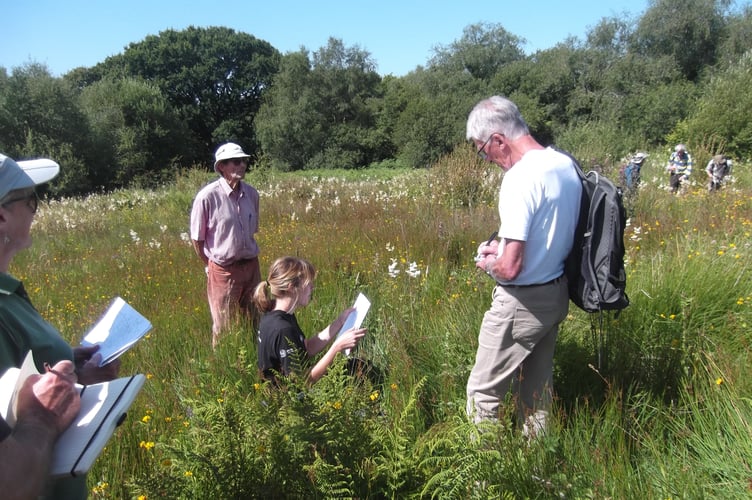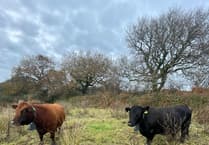Heath Lobelia is and always has been a very rare plant in Britain, growing in a few wet heaths and grasslands. It is only regularly found in six locations, all in southern England.
It was first seen near Axminster, on Shute Common in the 1770s. In 1889 Capt, Harris Wise of Woolston House found Heath Lobelia growing on Stanton Moor, two miles north of Loddiswell. In the 1960s Col. and Mrs.Walker lived at Woolston House. They also owned the grassland fields and woodland on Stanton Moor. Their son Andrew loved exploring the woodland. He discovered the ruins of an old farmhouse and began excavating it. Sadly, Andrew was killed in a traffic accident in 1969. His heartbroken parents moved from the area and leased and later sold Stanton Moor to the Devon Wildlife Trust, on condition that they changed its name to Andrew’s Wood.
Volunteers are always welcome to help keep the clearings in the reserve open enough for the Lobelia to survive and for its seeds to germinate. We meet on the second Thursday of each month, at the car park near the main road about half a mile south of California Cross.
There are four main clearings where the Lobelia grows. Each has a name and each has a story. Top Clearing is below the gate at the bottom of the track down from the car park. Not only is it higher than the rest of the wood it also usually has the highest counts. Below Top Clearing is Aspen Clearing, where a group of aspen trees grow. To the left is a small clearing called Dragonfly; often a good place to sit and wait to see dragonflies. The last Lobelia clearing is at the western end of the reserve and is called Two Andrew’s. Two oak trees have been left to grow in memory of Andrew Walker, after whom the reserve is named, and Andrew Shaw who also died young
The first full count of all the Lobelia plants in Andrew’s Wood was in 1975. There has been a count, sometimes two counts, in every year since, except in 2020 when COVID stopped so many things. Lobelia plants only live to about six years and the usual pattern is a burst of new plants germinating, when conditions are right, with plenty of bare ground. For the next six years or so there is a decline. Our counts have gone up and down. During the fifty years counting there have been six or seven cycles of rise and fall. The highest counts were around 2001, when a total of 14,000 were counted. Last year’s count was only about 500, the lowest count ever. But we are working hard to encourage the next blue-burst of Lobelia.
A dozen of us were braving the heat last week with Lineke, our leader, to do a preliminary check this month. Lobelia may have been our main object but, as always, we found so many other fascinating things.
Lineke gives is our instructions and shows us a Lobelia plant. Can you see the meadowsweet dappling the rushy meadow?

The flowers in Top Clearing were wonderful, after the work we had done during the winter clearing the willow and birch scrub. The flora is flourishing again. The marsh orchids have done well. Birdsfoot trefoil is abundant; it is a favourite food-plant for the caterpillars of blue butterflies and the red and black burnet moths. The scarce, yellow bartsia has spread. The most impressive sight was the creamy-white, sweetly-scented meadowsweet dappling the rushy meadow.
After an hour recording the flowers in Top and Aspen Clearing, Lineke took her slightly wilting volunteers into the shady, mysterious wood for a picnic lunch. If you went down to the wood that day, you’d be in for a big surprise, for every Lobelia counter was gathered there...
.jpeg?width=752&height=500&crop=752:500)
Butterflies are doing well in Andrew’s Wood this year. Rebecca Hosking spotted this male brimstone butterfly, as we were looking for Lobelia in Dragonfly Clearing. It was perched on a marsh thistle flower, surrounded by a forest of bracken. She crept slowly through the bracken, trying not to disturb the foliage or the butterfly. At last she was close enough. She raised her camera, the brimstone opened its wings to fly, Rebecca pressed the button and here it is.
Male Brimstone Butterfly, in flight from a Marsh Thistle.
.jpeg?width=752&height=500&crop=752:500)
Brimstone butterflies are amazing. Many species of butterflies have only short lives as adults, spending more time as caterpillars, pupae or eggs. Brimstones lay their eggs on alder buckthorn leaves in May or June, the caterpillars soon hatch and chew the leaves for about a month. By July they will have turned into pupae and in a few weeks will have emerged as beautiful adult butterflies, in late July or August. Some of the aged parents may live to see their offspring flying. Those offspring will fly until Autumn causes them to hibernate,. They awaken on sunny days in early Spring, to mate and start the magic story again.
Join us for our count on Thursday 14th August, at10 o’clock in the car park, to visit the magic wood.



-Cleared-for-use-by-LDRS-partners.jpeg?width=209&height=140&crop=209:145,smart&quality=75)

Comments
This article has no comments yet. Be the first to leave a comment.